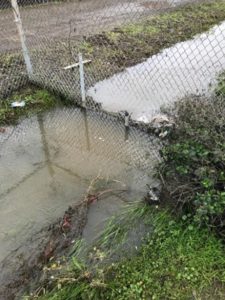Industrial Stormwater Lawsuits
Violations of the industrial stormwater general permits (IGP or ISGP) or multi-sector general permits (MSGP) can carry stiff financial penalties. In California, industrial stormwater discharges that violate the IGP carry up to a $37,500 per day penalty. Under the Clean Water Act (CWA), environmental groups can file citizen lawsuits against companies for violations of their stormwater permit. As part of the 60-day notice of intent to sue, environmental groups will typically attach a list of days that had rain events which the violations occurred on and/or stormwater samples were not collected (see below).
Rain Logs Matter
This is where your rain log comes into incredibly handy. If you have a list of all the storm events, precipitation amounts, and whether you sampled or not, you can push back on these allegations of 1) discharge and 2) not sampling. Most facilities are not even keeping a rain log. 
For the ones that do keep a rain log, it is usually a binder, excel sheet, or piece of paper on a clipboard. Unfortunately, staff are busy and not every rain event gets logged. In addition, recordkeeping with paper can be a hassle. Environmental or EHS managers might not be sitting in the same location as the facility and thus cannot access the rain log. The three most common problems we see with rain logs are:
- Rain logging does not occur;
- Rain logs are stored on paper at another location; and
- Paper logs are not kept for five years (permit requirement).
When a notice of intent to sue hits or an inspector shows up, facilities, unfortunately, have limited ways to push back or show that they were in compliance with their industrial stormwater permit.
What Should Be In a Rain Log
Rain logs should have a few components that address the aforementioned allegations in lawsuits and enable environmental and EHS managers to ensure samples are being collected. A good rain log should track the following:
- Rain start and end date/time
- Stormwater samples collected (yes/no)
- Notes on whether discharge occurred
- Amount of rain
How Automatic Rain Logs Work
Mapistry’s stormwater compliance platform takes this all a huge step forward. Because we know facility staff are really, really busy and rain logs do not get done. We automated the logging of storm events. Now when a user of Mapistry logs in, they just have to confirm or deny that the rain event we logged was correct. They can add in whether a sample was collected or there was no discharge. This helps ensure rain is being tracked, gives managers insight into staff responsibilities (e.g. sample collection), and helps a facility meet their record-keeping requirement (e.g. one of the core Best Management Practices [BMPs] and a required, minimum BMP in California).
Why Make Stormwater Permits Hard On Yourself?
Automatic rain logs combined with upcoming storm event notifications, Mapistry’s stormwater compliance platform keeps facilities on top of complex sampling requirements. To learn more about how our proprietary technology works.
